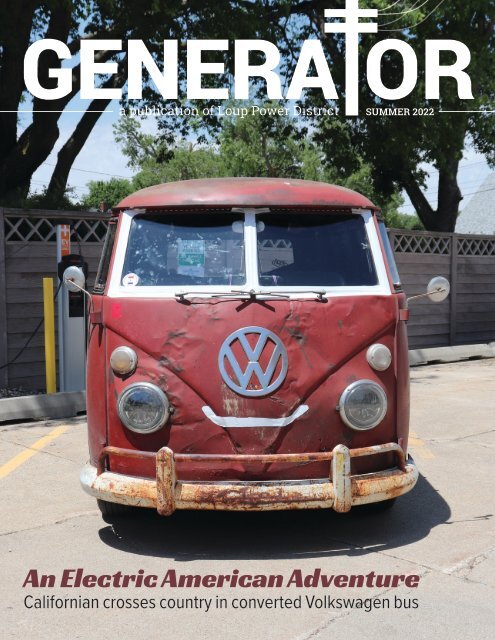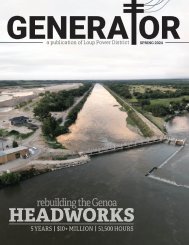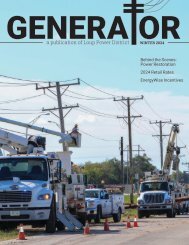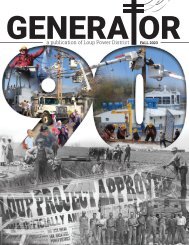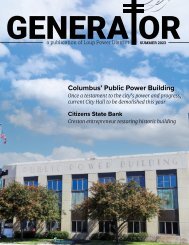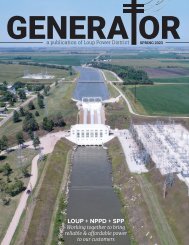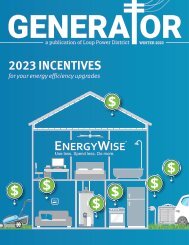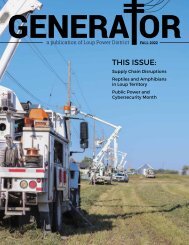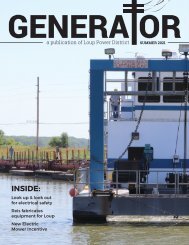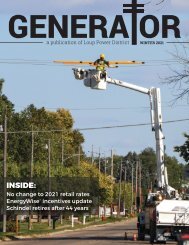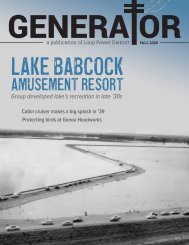Generator—Summer 2022
In this edition: A Californian retraces Horatio's Drive and the Lincoln Highway in a 1964 Volkswagon Bus converted to run on electricity; an underwater inspection at the Monroe Powerhouse; summer safety tips; and more.
In this edition: A Californian retraces Horatio's Drive and the Lincoln Highway in a 1964 Volkswagon Bus converted to run on electricity; an underwater inspection at the Monroe Powerhouse; summer safety tips; and more.
You also want an ePaper? Increase the reach of your titles
YUMPU automatically turns print PDFs into web optimized ePapers that Google loves.
GENERA OR<br />
a publication of Loup Power District SUMMER <strong>2022</strong><br />
An Electric American Adventure<br />
Californian crosses country in converted Volkswagen bus
BOARD OF DIRECTORS<br />
president’s message<br />
around the district<br />
Alan Drozd<br />
Chairman<br />
Steve Heesacker<br />
First Vice Chairman<br />
Robert Cerv<br />
Second Vice Chairman<br />
Loup developing<br />
time-of-use rates<br />
Jim Donoghue<br />
Secretary<br />
Dick Tooley<br />
Treasurer<br />
Rich Aerni<br />
Mike Fleming<br />
Ross Knott<br />
Chris Langemeier<br />
Larry Zach<br />
EXECUTIVE STAFF<br />
Neal Suess<br />
President/CEO<br />
Walt Williams<br />
Vice President,<br />
Accounting & Finance/CFO<br />
In the world of customer service,<br />
there is an old adage that states<br />
“the customer is always right,” or<br />
to change it slightly, “the customer<br />
always knows what he/she wants.”<br />
This is a great statement, but in the<br />
electric industry, we tend to provide<br />
a product that is pretty basic in its<br />
nature. At the District, we provide<br />
electricity with a customer service<br />
charge, an energy charge, and,<br />
with some rates, a demand charge.<br />
Pretty basic.<br />
We have worked closely with our<br />
power supplier, Nebraska Public<br />
Power District (NPPD) to come up<br />
with other products that we can provide for the<br />
end-use customer.<br />
NEAL SUESS<br />
President/CEO<br />
These include such products as our<br />
net metering rate, for installation of<br />
customer-owned generation (such<br />
as solar panels). Loup and NPPD<br />
are also working on other products<br />
regarding interruptible rates for<br />
large industrial customers and<br />
demand response rates that could be<br />
available for a number of different<br />
types of customers and processes.<br />
Additionally, at some point,<br />
Loup will develop residential and<br />
commercial time-of-use rates for<br />
end-use customers, which reflect<br />
the cost of purchasing energy from<br />
NPPD at various time periods. We<br />
would bill customers accordingly.<br />
Loup currently has time-of-use rates for certain<br />
large industrial customers.<br />
Todd Duren<br />
Vice President,<br />
Corporate Services<br />
Korey Hobza<br />
Vice President, Engineering<br />
Dan Hellbusch<br />
Vice President, Operations<br />
The Loup Generator is<br />
published quarterly<br />
as a service for Loup<br />
employees, families,<br />
friends, and associates.<br />
For feedback, story ideas<br />
and submissions, contact:<br />
Stacy Wemhoff<br />
Communications Coordinator<br />
402-562-5711<br />
swemhoff@loup.com<br />
These include the availability of all products under<br />
NPPD’s EnergyWise program:<br />
• Incentives on new electrification products<br />
(electric vehicles, chargers and lawn mowers)<br />
• Energy efficiency programs such as air conditioning<br />
and heating system tune-ups, which<br />
can reduce electric usage<br />
• New appliances with higher efficiency ratings<br />
for the homeowner<br />
In addition, Loup Power District and other<br />
wholesale customers of NPPD are working on raterelated<br />
products that can benefit our companies,<br />
NPPD, and end-use customers.<br />
These rates could even include a demand component<br />
for commercial and residential customers.<br />
Many of these rate concepts are still in the development<br />
stages.<br />
Often times we are asked what products are available<br />
for specific customers. We are happy to work<br />
with our customers to provide information that<br />
may help save the customer money in the long<br />
run. All you need to do is ask or look it up on our<br />
website, loup.com.<br />
Keep watching the District’s website for more information<br />
on products and services that may become<br />
available in the future. These will be important to<br />
all of us and will help go a long way toward maintaining<br />
a great relationship between the District<br />
and its customers.<br />
TIME-OF-USE PRICING<br />
Time-of-Use pricing is an electric rate schedule that<br />
adjusts the price of your electricity based on when<br />
you’re using it.<br />
Time-of-Use pricing is intended to encourage you to use<br />
electricity during off-peak hours when power is cheaper<br />
and demand is lower, helping to alleviate strain on the<br />
electric grid.<br />
VEHICLE DAY<br />
Genoa Local Superintendent Dominic Zoucha (above)<br />
answered questions about Loup’s truck and backyard digger<br />
at the annual Vehicle Day at Ag Park in Columbus. Greg<br />
Badstieber, Customer & Energy Services Coordinator, and<br />
Todd Duren, Vice President of Corporate Services, showed<br />
the kids the District’s all-electric Ford Mustang Mach-E.<br />
The event was hosted by the Columbus Area Chamber of<br />
Commerce.<br />
HOUSE MOVE BY TARNOV<br />
Loup Power District assisted with a home move by Tarnov in<br />
June. Journey Line Technician Jared Hoefelman took this shot<br />
to show us the view from above as they raised the power<br />
lines. Newman Grove Local Superintendent Alvin Meyer is<br />
pictured in the background.<br />
INTERN EDUCATION<br />
Journey Line Technician Andy Wallin<br />
demonstrates the installation of<br />
preformed conductor ties for intern<br />
Mason Hinze.<br />
Hinze is one of several interns<br />
working at Loup this summer. He is<br />
studying Utility Line at Northeast<br />
Community College.<br />
Logan Weineke, Ean Luebbe, Alex<br />
Ritzdorf, and Harrison Weyers<br />
are also working at Loup for the<br />
summer.<br />
Photo by Mike Brabec.<br />
2 | GENERATOR<br />
SUMMER <strong>2022</strong> | 3
Horatio’s Drive<br />
& The Lincoln Highway<br />
an electric American adventure<br />
Jack Smith pushed a skateboard across<br />
America four times.<br />
Then he rode an electric skateboard from<br />
Oregon to Washington, D.C.<br />
That might be enough adventure for most<br />
people. But Smith isn’t like most people.<br />
“I’ve been attracted to crossing the<br />
country in different ways,” he said.<br />
In early June, Loup Power District<br />
employees saw a vintage Volkswagen van<br />
pull up to the electric vehicle charging<br />
station in the parking lot.<br />
They had to investigate. This was indeed<br />
“different.”<br />
And so, we met Smith and his childhood<br />
friend, Larry Newland, and asked them to<br />
share their stories.<br />
HORATIO’S DRIVE<br />
Last year, Smith sat down to watch the<br />
Ken Burns documentary “Horatio’s Drive” at<br />
his home in California.<br />
It tells the story of Dr. Horatio Nelson<br />
Jackson. He was at San Francisco’s University<br />
Club in May 1903 when he made a<br />
$50 bet (equivalent to more than $1,500<br />
today) that he could cross the country in an<br />
automobile.<br />
A few days later, he purchased a<br />
20-horsepower Winton touring car. He was<br />
31 years old with very little driving experience<br />
and no maps to follow. The country had<br />
only 150 miles of paved roads.<br />
Five days after the bet, he took off with<br />
Sewall K. Crocker, who served as travel<br />
companion, mechanic, and backup driver.<br />
A bull terrier named “Bud” joined them<br />
in Idaho. He was outfitted with goggles to<br />
protect his eyes as he helped watch the road.<br />
Most people doubted that the automobile<br />
had a future. But Jackson proved them<br />
wrong when he arrived in New York City 63<br />
days later.<br />
Smith was hooked on the story immediately.<br />
After he watched the video, he bought<br />
a book and delved into the story even more.<br />
Then, he decided it wasn’t enough for<br />
him to simply read about Horatio’s drive. He<br />
wanted to make it.<br />
“I told my wife, ‘I want to retrace this<br />
guy’s route, but I don’t want to do it in a<br />
regular vehicle.”<br />
Left: Horatio Nelson Jackson and Sewall Crocker on their cross-country journey in 1903. They traveled in a 20-hp Winton touring car.<br />
Right: The pair faced mechanical issues, navigational problems, and bad roads. Photos courtesy of Silver Special Collections, University of Vermont.<br />
SKATEBOARDS ACROSS AMERICA<br />
Most Americans have never traveled<br />
across the entire country. Smith has done<br />
it multiple times — but never in a “regular<br />
vehicle.”<br />
Back in 1976, at 19 years old, he and three<br />
friends became the first to skateboard across<br />
America, with sponsorship from a company<br />
called Roller Sports.<br />
They did so in leapfrog fashion, with each<br />
skater going about three miles at a time.<br />
In between, the skaters got a ride in their<br />
support car — a 1969 Firebird.<br />
Each guy skated a total of 35–50 miles<br />
daily, depending on the terrain. As a team,<br />
they could travel 150 miles on a good day.<br />
The trip from Oregon to Virginia took 32 days.<br />
“It was a great way to see the country,”<br />
Smith said. “You’re going so slow, you don’t<br />
miss anything.”<br />
If anything, the trip only expanded<br />
Smith’s love of skateboarding. He competed<br />
in the infamous “Signal Hill Speed Run” in<br />
Signal Hill, Calif., held from 1974–78.<br />
Participants in the race set world records<br />
in skatecars, topping out at almost 60 miles<br />
per hour on the hill with a 30-degree drop.<br />
The annual event ended when sponsors<br />
withdrew because it became too dangerous,<br />
with multiple life-threatening crashes.<br />
By 1984, the “new guys” on the skateboarding<br />
scene were tired of hearing all<br />
Smith’s stories. They wanted stories of their<br />
own, and asked if he would consider another<br />
cross-country trip.<br />
It didn’t take much convincing. The fourman<br />
team took on the task again, raising<br />
money for Multiple Sclerosis awareness<br />
along the way. The journey took 26 days.<br />
In 2003, Smith’s son, Jack, died of complications<br />
from Lowe Syndrome, a rare genetic<br />
disease. His father died of Alzheimer’s<br />
Disease in 2013.<br />
Smith made two more cross-country trips<br />
to raise funds and awareness for those conditions<br />
in the years they died.<br />
That fourth trip in 2003 included his<br />
younger son, Dylan. The 3,618-mile journey<br />
set a world record that was broken by British<br />
skateboarder David Cornthwaite in 2007.<br />
By 2018, Smith was referred to as a<br />
“skateboarding legend” by media outlets<br />
and his fellow peers.<br />
It might have been enough for most<br />
people. But again, Smith isn’t like most<br />
people.<br />
That year, he decided it was time for one<br />
more trip. But this time, he was going to go<br />
solo on an Inboard M1 electric skateboard.<br />
The 2,394-mile journey from Eugene,<br />
Oregon, to the steps of the Smithsonian<br />
Museum took 45 days.<br />
He was 61 years old.<br />
Story by Stacy Wemhoff<br />
Jeff French, Jack Smith, and Mike Filben pushed their<br />
4 | GENERATOR<br />
Jack Smith (left) and Larry Newland charged<br />
the Rust Bus at Loup Power District’s<br />
electric vehicle charging station on June 3.<br />
skateboards across the United States in 1976. Smith also<br />
crossed the country on an electric skateboard in 2018.<br />
Photos courtesy of Jack Smith.<br />
SUMMER <strong>2022</strong> | 5
LARRY & THE LINCOLN HIGHWAY<br />
Smith successfully completed Horatio’s<br />
drive east. After a short break, it was time to<br />
head home.<br />
And this time, he was going to follow the<br />
Lincoln Highway — the first transcontinental<br />
road in the United States.<br />
The highway was dedicated in 1913 and<br />
ran from Times Square in New York City to<br />
Lincoln Park in San Francisco. Cities and<br />
towns along the 3,389-mile route prospered<br />
as travelers took to “America’s Main Street.”<br />
The Lincoln Highway was gradually<br />
replaced with numbered designations in<br />
1926. Much of the route is now U.S. Highway<br />
30.<br />
Smith took a short break in New York<br />
and it was time for Mike Adamski to head<br />
home. But he got a new companion for the<br />
second leg of the journey — his friend Larry<br />
Newland.<br />
Newland was one of the first people<br />
Smith met when his family moved to Morro<br />
Bay, Calif.<br />
Like Smith, he is lured by adventure.<br />
He once walked a portion of the Donner<br />
Party route from Reno, Nev., over the Sierra<br />
Nevada mountains into Placerville, Calif.<br />
He had planned to be a part of Smith’s<br />
1976 skateboard trip, but backed out because<br />
he started a rock band.<br />
“Almost 50 years later, here we are on a<br />
cross-country trip,” Smith said.<br />
There is no fundraising cause for this trip.<br />
“It’s just a fun adventure,” he said.<br />
But their costs were minimal. At night,<br />
the pair typically stayed at campgrounds.<br />
Smith slept in the bus on top of the batteries,<br />
while Newland pitched a tent. They plugged<br />
in the bus to charge overnight so they were<br />
ready to hit the road by morning.<br />
Along the way, they met a lot of interesting<br />
people who were intrigued by the<br />
bus and wandered over to take a look —<br />
young and old, police officers, construction<br />
workers in downtown Manhattan.<br />
“It’s an attention magnet,” Jack said.<br />
“First they come up and they’re excited by<br />
the bus because they think it’s cool,” he said.<br />
“It makes them smile.”<br />
When they found out it was electric, they<br />
wanted to see the motor and batteries.<br />
The pair was always willing to show off<br />
the bus, talk about their adventures, and<br />
answer questions.<br />
The most popular question?<br />
“How far can you go on a charge?”<br />
THE RUST BUS<br />
Smith was only three years out from his<br />
electrified skateboard trip when he watched<br />
“Horatio’s Drive.”<br />
Still, the prospect of another journey was<br />
too exciting to ignore. It wasn’t a question of<br />
if he’d recreate the trip, but how.<br />
He contacted his friend, Michael Bream,<br />
owner of EV West in San Marcos, Calif. Smith<br />
wanted to get some input and ideas for this<br />
trip.<br />
Bream immediately offered the “Rust<br />
Bus,” a 1964 VW van that he converted to run<br />
on all-electric power.<br />
At first, Smith was a little skeptical.<br />
He was hoping for a Tesla, or maybe the<br />
DeLorean that Bream was converting. But it<br />
Jack Smith charged the bus<br />
at Loup Power on May 15<br />
as he journeyed east from<br />
California to New York. He<br />
stopped a second time on<br />
the return journey on June 3.<br />
He took photos of the Rust<br />
Bus all along the way.<br />
They spent most nights at<br />
low-cost campgrounds —<br />
Smith slept in the bus<br />
while his companion<br />
slept in a tent.<br />
They charged the bus at<br />
their campsite overnight.<br />
wasn’t ready.<br />
And so, he decided the two-speed bus<br />
would have to do.<br />
“It’s a very basic vehicle,” Smith said.<br />
“Just as Horatio’s was.”<br />
But basic doesn’t quite describe the<br />
vehicle, with its contrasting vintage frame<br />
and new technology —an electric motor<br />
and charging port, and 800 pounds of Tesla<br />
batteries.<br />
And, Smith realized, that’s just what he<br />
was looking for.<br />
On May 4, he hopped in the rust bus and<br />
headed west from San Francisco with friend<br />
Mike Adamski.<br />
They soon learned they wouldn’t exactly<br />
be traveling in comfort. The bus rattled,<br />
and leaked, and the ride was often bumpy,<br />
despite the upgraded shocks.<br />
They hit cold spring weather and snow on<br />
the early part of the journey. Smith wore long<br />
underwear and gloves. The cold air snuck in,<br />
despite the tape on the windshield and the<br />
added foam insulation.<br />
Still, Smith knew he didn’t have it so bad,<br />
when he compared his experience to that of<br />
Jackson.<br />
“Those guys were in an open-cockpit car<br />
navigating by compass,” he said.<br />
In contrast, he had navigation equipment,<br />
paved roads, modern amenities, and<br />
more.<br />
Twenty-one days after leaving California,<br />
Smith and Adamski reached New York.<br />
1916 Lincoln Highway Official Road Guide<br />
FROM A TRICKLE TO A FIRE HYDRANT<br />
Newland kept a log every day of the<br />
journey. The top speed of the Rust Bus is<br />
about 95 miles per hour. Generally, they took<br />
a leisurely pace of about 40–55 miles an hour<br />
since they traveled mostly on state highways<br />
and some back roads.<br />
He loved that part of the trip.<br />
After all, he asked, are you really seeing<br />
our country if you’re barreling down the<br />
interstate at 70 miles an hour?<br />
They averaged about 20 miles per 10<br />
percent of battery power on their trip west.<br />
That equates to about 200 miles per<br />
charge in ideal conditions. That range<br />
decreased in hilly terrain or windy<br />
conditions.<br />
But a 200-mile range is just fine with<br />
Newland. After a few hours in the car, he<br />
needed a break to stretch his legs and get a<br />
cup of coffee or bite to eat.<br />
He believes that is a business model for<br />
the future. Imagine charging your car while<br />
having coffee with a friend or getting your<br />
groceries. Convenience stores could add<br />
amenities for EV owners who need to take a<br />
break from the road and charge up.<br />
“This trip has helped shape my idea<br />
about the viability of electric vehicles,”<br />
Newland said.<br />
He’s guessing that in 5 to 10 years, most<br />
people will have an electric car that they use<br />
for trips to the store, to school, to work. But<br />
they will also have a gas-powered pickup<br />
or car for their family vacations or home<br />
improvement projects.<br />
He knows not everyone sees electric<br />
vehicles in such a positive light, but he also<br />
witnessed people change their mind after<br />
learning about the bus and their trip.<br />
Some were shocked at the bus’ instant<br />
torque. Others learned that the most they<br />
paid for a charge was about seven bucks— a<br />
lot cheaper than a full tank of gas.<br />
But Newland said the range question is<br />
the main drawback for many.<br />
“When the first question ceases to be,<br />
‘how far can you go on a charge,’ electric<br />
cars are going to take off,” he said.<br />
For true success, he thinks potential EV<br />
owners will need to see charging stations at<br />
every gas station. They will need a range of<br />
300 miles. Five hundred would be better.<br />
And finally, the cost of a new EV needs to<br />
come down.<br />
He knows that will happen. New technology<br />
is always expensive, but eventually<br />
the price comes down.<br />
Smith is also convinced that electric cars<br />
will eventually take off — just like other<br />
inventions throughout history that found<br />
plenty of skeptics. Heck, Horatio may never<br />
have made history if he didn’t bet against<br />
those naysayers more than 100 years ago.<br />
“It’s going to start as this trickle,” he said.<br />
“And then it’s going to be like a fire hydrant.”<br />
The electric motor in the Rust Bus is<br />
powered by Tesla batteries.<br />
6 | GENERATOR SUMMER <strong>2022</strong> | 7
LEADING THE CHARGE<br />
Electric motors give new life to classics<br />
Michael Bream owns<br />
EV West in San Marcos,<br />
Calif. The company<br />
converts vehicles to run<br />
on electric power.<br />
Above: Some “new”<br />
electric vehicles.<br />
Photos courtesy of EV West<br />
Story by Stacy Wemhoff<br />
Back in 1974, the parking brake on a Volkswagen<br />
bus failed and it rolled down a hill.<br />
Right into an elm tree.<br />
The owners pulled it back to their property where<br />
it sat for more than 40 years. Then they asked Michael<br />
Bream if he’d like to have it.<br />
“It looked really bad,” he said. “So of course we<br />
were interested.”<br />
Bream took the 1964 VW bus back to his business,<br />
EV West, in San Marcos, Calif. There, he and his team<br />
fixed the frame as best they could.<br />
They removed the old combustion engine, and<br />
replaced it with an 88-kilowatt AC motor (about 120<br />
horsepower). Then, they added Tesla batteries.<br />
It went into the business’ vehicle pool and<br />
employees put about 40,000 miles on it in a few years.<br />
“Because it came in so messed up and the fact that<br />
it’s now so capable, it’s become very endearing for the<br />
employees and the people around here,” Bream said.<br />
“Everybody just loves the Rust Bus.”<br />
The bus is one of many vehicles Bream has<br />
converted to run on all-electric power. He worked on<br />
Tony Hawk’s Corvette Stingray this summer. Add to the<br />
mix a 1951 Chevy pickup, a few Porche conversions,<br />
and several more VW buses.<br />
But he doesn’t do it for the environment. Or<br />
because gas prices are so high. It’s not a political<br />
statement.<br />
He does it to save the classics.<br />
“We just wanted to highlight the performance,<br />
highlight the fun, highlight the fact that you can save a<br />
classic car like this bus,” Bream said.<br />
HOT ROD CULTURE<br />
Bream’s interest in cars stems from his father.<br />
“My dad grew up in West Hollywood in the ’50s and<br />
’60s and there was a lot of hot rod culture,” he said.<br />
He began racing cars and did that for about 5 years.<br />
While that was a lot of fun, Bream is an engineer, and<br />
decided he wanted to step things up a notch.<br />
“I just wanted something more cerebral,” he said.<br />
“I wanted to push the limits a little bit more.”<br />
He decided to build an electric race car and<br />
compete in the Broadmoor Pikes Peak International<br />
Hill Climb — an annual race to the summit of Pike’s<br />
Peak. The event is the second-oldest motorsports<br />
race in America. It began in 1916 and was halted only<br />
during both world wars.<br />
The 12.42-mile course has 156 turns. It begins at<br />
about 9,300 feet and ends 14,115 feet above sea level.<br />
Bream and his father built their electric car over<br />
a year and a half and were ready to compete in 2012.<br />
They broke a record in their class and beat out cars<br />
that were funded by multi-million dollar companies.<br />
The David-versus-Goliath win led to news stories.<br />
His name began circulating among car enthusiasts.<br />
“I think that was the major impetus for what is now<br />
EV West,” Bream said.<br />
SAVING THE CLASSICS<br />
Bream’s business has continued to grow as more<br />
and more people decide to save their classics by<br />
converting them to electric power.<br />
Again, Bream said he and his customers don’t<br />
have an altruistic motive for doing so. They enjoy the<br />
We’re like a bunch of kids having<br />
fun with classic cars that drive much<br />
“better than they did 50 years ago.<br />
instant power and low maintenance that comes with<br />
an electric motor.<br />
“We’re like a bunch of kids having fun with classic<br />
cars that drive much better than they did 50 years<br />
ago.”<br />
Plus, gas is a finite resource and gas engines have<br />
a lot of moving parts and therefore a lot of potential<br />
problems. The problem is compounded in classics<br />
because of their age.<br />
“But you put this electric drive line in it and<br />
going back and forth across the United States is no<br />
problem,” Bream said.<br />
It wasn’t a problem for his friend, Jack Smith, who<br />
traveled back and forth across America in an electric<br />
vehicle as he recreated “Horatio’s Drive.”<br />
Bream learned about that first trip across America<br />
when Smith gave him a book about the journey.<br />
“I was so fascinated by it,” he said. “It’s a snapshot<br />
in time when something seemed so unobtainable. To<br />
drive across the country seemed impossible.”<br />
And so, when Smith wanted to recreate the journey<br />
in a unique vehicle, Bream offered the Rust Bus.<br />
The vehicle was up to the task. And while Smith’s<br />
adventure is now complete, the bus still has work<br />
to do. It’s headed to Canada this month to join other<br />
vintage VWs on a trip from Canada to Mexico. It will<br />
most likely amaze and delight those who come over for<br />
a closer look. Just like it did on the Smith’s trip.<br />
“It’s fun to have something that was the total peak<br />
of unreliability and then doing the exact opposite with<br />
it — making it something that can drive around the<br />
United States with virtually zero maintenance.”<br />
LEARN MORE:<br />
“Horatio’s Drive” on PBS<br />
to.pbs.org/39zWtqc<br />
Learn more about the Ken Burns documentary on Horatio Jackson Nelson that<br />
features Tom Hanks as the voice of Dr. Jackson. This site includes video clips,<br />
photos, an automobile chronology timeline, and more.<br />
Following Horatio’s Route and the Lincoln Highway<br />
bit.ly/FirstRoadTrip<br />
Jack Smith documented his travels on his Facebook page. Search “An Electric<br />
Tribute to America’s First Road Trip and The Lincoln Highway.” Mike Newland<br />
shared pictures on Instagram under the handle @horatio1903.<br />
Beyond the Sidewalk<br />
bit.ly/1stSkate<br />
“Beyond the Sidewalk” is an eight-minute short film about the first skateboard<br />
push across America in 1976.<br />
Smithsonian National Museum of Natural History<br />
s.si.edu/39K67X3<br />
Several of Smith’s possessions are now part of the permanent collection at the<br />
Smithsonian National Museum of American History: the first skateboard Smith<br />
used in 1976; his gray suede Vans shoes worn on the 2013 trip; and his electric<br />
skateboard, T-shirts, and safety vest from 2018. Pictures of the items are posted<br />
on the museum’s website.<br />
The museum also has items from Horatio Nelson Jackson in its collection.<br />
View the car, Bud’s goggles, and more at s.si.edu/39Ew3n2<br />
The Lincoln Highway<br />
lincolnhighwayassoc.org<br />
The Lincoln Highway Association is dedicated to preserving and celebrating<br />
an important part of American history.<br />
8 | GENERATOR<br />
SUMMER <strong>2022</strong> | 9
UNDERWATER<br />
INSPECTION<br />
The Columbus and Monroe powerhouses<br />
are impressive structures.<br />
But they are more than 80 years old and<br />
need regular tending. The employees who<br />
work there every day spot mechanical and<br />
structural issues on the inside and outside.<br />
But what about under?<br />
That’s where things get a little more<br />
tricky.<br />
There are trash rack supports under the<br />
water on the upstream side of the Monroe<br />
Powerhouse (MPH). These racks prevent<br />
debris from entering the generator turbines<br />
and regulating wicket gates.<br />
Last year, employees noticed<br />
that the wear plates that protect<br />
these supports were deteriorating and<br />
needed maintenance.<br />
Accessing underwater areas of the<br />
canal is no easy task, however. That’s why<br />
the MPH trash racks and supports had not<br />
been inspected in almost 20 years.<br />
In May, Loup employees completed<br />
the task with the assistance of a diver and<br />
crane team.<br />
The project was scheduled for that time<br />
because Loup could lower the upstream<br />
water level without affecting canal irrigators.<br />
After clearing the<br />
debris, the location<br />
was dewatered using<br />
bulkheads (stop logs) to<br />
seal off the canal.<br />
Each of the two generator<br />
intakes is divided into<br />
two sections. Each<br />
requires three stop logs<br />
stacked on top of each<br />
other to provide a safe<br />
barrier between the canal<br />
and the work area.<br />
Once the stop logs were installed and<br />
each section was dewatered (above),<br />
the trash rack sections were removed<br />
(left) with the help of a crane. The racks<br />
were tagged, cleaned, and inspected.<br />
Top: Kenny Ferris with Husker Marine of Burwell prepares to check for debris at the powerhouse.<br />
Above left: Lance Ferris, Canal Lead, and Brad Morton, Hydro Superintendent, monitor the dive<br />
from the powerhouse deck.<br />
Above middle: Lance Ferris (right) helps Kenny Ferris replace his oxygen tank.<br />
Right: A log is removed from the bottom of the canal after being discovered by the diver.<br />
Photos by Brad Morton, Lance Ferris, and Stacy Wemhoff.<br />
After the racks are removed, the support structure<br />
is inspected (right) and repaired as needed (above).<br />
Then the racks are reinstalled, the stop logs are<br />
removed to allow water back into the scroll case,<br />
and the generator is placed back into service.<br />
10 | GENERATOR SUMMER <strong>2022</strong> | 11
Area students earn scholarships<br />
LINKAGES SCHOLARSHIPS<br />
LOUP POWER DISTRICT SCHOLARSHIPS<br />
Linkages Scholarships were awarded to Columbus area high school graduates<br />
Jack Ryan and Tim Sliva.<br />
The Linkages Program is a nationally recognized program that supports high<br />
schools offering a quality program of engineering and technology courses. The<br />
Columbus Economic Council, Loup Power District, and local businesses provide<br />
support for the program.<br />
The students qualified for the Linkages Scholarship by taking engineering and<br />
technical courses. The scholarship can be used at each student’s college of<br />
choice.<br />
The following local sponsors provided important financial support to this year’s<br />
program: ADM Corn Processing, Behlen Mfg. Co., Columbus Bank, Columbus<br />
Community Hospital, Duo Lift Manufacturing, Pinnacle Bank, TORIN Products,<br />
Inc., and Valmont Newmark.<br />
Since its beginning in 2004, the Linkages Program has awarded 205 scholarships<br />
totaling $66,675.<br />
Loup Power District awarded scholarships to six<br />
area students who are attending Central Community<br />
College-Columbus this fall.<br />
Loup Power District scholarships are awarded to high<br />
school seniors living in Boone, Colfax, Nance, and<br />
Platte Counties, and a portion of Madison County.<br />
Selection is based on academic achievement,<br />
employment and school activities, quality of the<br />
personal statement, application completeness and<br />
recommendations.<br />
Scholarships were awarded to: Columbus High School<br />
— Kyson Krepel; Scotus Central Catholic — Noah<br />
Bierman; Lakeview High School — Hunter Schoch;<br />
Clarkson High School — Bryce Jurgesen; Lindsay Holy<br />
Family — Grace Preister; St. Edward High School —<br />
Andrew Breceda.<br />
GAVIN BRABEC<br />
Scotus Central Catholic<br />
—<br />
Plans: Pre-medicine<br />
at University of Nebraska at Omaha<br />
Son of Lori and Mike Brabec, Crew Lead<br />
SYDNEY QUINN<br />
Scotus Central Catholic<br />
—<br />
Plans: Veterinary Technology<br />
at Northeast Community College<br />
Daughter of Crystal and Dan Quinn, Crew Lead<br />
DELANEY MARY OLMER<br />
Humphrey St. Francis<br />
—<br />
Plans: Health Sciences<br />
at University of Nebraska at Kearney<br />
Daughter of Tom and Ann Olmer,<br />
Customer Service Representative<br />
ADAM QUINN<br />
Scotus Central Catholic<br />
—<br />
Plans: Business and Marketing<br />
at Southeast Community College in Lincoln<br />
Son of Crystal and Dan Quinn, Crew Lead<br />
MASON PROSOSKI<br />
Northeast Community College<br />
—<br />
Associate’s Degree in Utility Line<br />
Working for Cornhusker Public Power District<br />
Son of Eric and Amber Prososki and Betsy<br />
and Kenton Zimmer, Equipment Operator;<br />
Grandson of Sena and Randy Prososki,<br />
Headworks Supervisor<br />
SIERRA QUINN<br />
Scotus Central Catholic<br />
—<br />
Plans: Pre-medicine<br />
at University of Nebraska-Lincoln<br />
Daughter of Crystal and Dan Quinn, Crew Lead<br />
$1.5M to<br />
area towns<br />
Loup Power District officials<br />
recently delivered lease payments<br />
totaling more than $1.5 million.<br />
Each of these communities owns<br />
their electric distribution systems.<br />
These payments compensate them<br />
for the use of those systems for the<br />
first quarter of <strong>2022</strong>. They use the<br />
funds for a variety of projects.<br />
The payments were:<br />
Columbus — $1,148,464.55<br />
Platte Center — $15,827.44<br />
Monroe — $14,604.30<br />
Tarnov — $2,084.55<br />
Creston — 8,806.06<br />
Humphrey — $30,743.01<br />
Lindsay — $57,390.32<br />
Cornlea — $2,410.37<br />
Newman Grove — $22,366.00<br />
Duncan — $20,617.76<br />
Fullerton — $37,866.12<br />
Genoa — $30,014.32<br />
Belgrade — $4,556.10<br />
Richland — $3,448.33<br />
Howells — $26,795.80<br />
Leigh — $19,081.91<br />
Clarkson — $23,319.13<br />
Albion — $57,242.83<br />
Cedar Rapids — $20,946.99<br />
Primrose — $1,907.98<br />
Petersburg — $11,263.72<br />
St. Edward — $22,054.15<br />
Total — $1,581,811.74<br />
HOW AMERICANS USE ELECTRICITY<br />
The latest data from the U.S. Energy Information Administration shows the<br />
combined use of clothes washers and dryers, dishwashers, small appliances and<br />
other electrical equipment (noted as “all other uses” below) accounts for the largest<br />
percentage of electricity consumption in American homes.<br />
1.7%<br />
TVs & Related Equipment<br />
41.3% 2<br />
All other uses<br />
15.7%<br />
Space Cooling<br />
4.1%<br />
Lighting<br />
11.8%<br />
Water Heating<br />
14.2% 1<br />
Space Heating<br />
Source: Energy Information Administration 2021<br />
1<br />
Includes consumption for heat and operating furnace fans and boiler pumps. <br />
2<br />
Includes miscellaneous appliances, clothes washers and dryers, stoves, dishwashers, heating elements, and motors.<br />
4.1%<br />
Computers &<br />
Related Equipment<br />
7.1%<br />
Refrigerators<br />
& Freezers<br />
12 | GENERATOR SUMMER <strong>2022</strong> | 13
employee notes<br />
JIM HOGE<br />
Drafting Technician<br />
Jim Hoge began<br />
his career at Loup<br />
in 1982 as a parttime<br />
Draftsman in<br />
the Engineering<br />
Department at the<br />
Columbus General<br />
Office. He was promoted<br />
to full-time<br />
as a Drafting Technician<br />
in 1986 and<br />
he continues in that position today.<br />
In this role, Hoge provides drafting<br />
support to all departments. He<br />
maintains District maps, including<br />
substation drawings, transmission<br />
line profile sheets, switching maps,<br />
and standards. Hoge works closely<br />
with Nebraska Public Power District<br />
regarding joint-use drawings that are<br />
shared between the two utilities. He<br />
also works with the City of Columbus<br />
on updating District maps with city limit<br />
changes, subdivision additions and<br />
new address assignments.<br />
A graduate of Columbus High School,<br />
Hoge attended Central Community<br />
College in Columbus. He and his wife,<br />
Sue, have twin girls — Jaime Sack and<br />
Nicole Liss. They also have two granddaughters<br />
and triplet grandsons.<br />
KYLE KEMPER<br />
Line Technician<br />
Kyle Kemper of<br />
Genoa joined Loup<br />
Power District as a<br />
Line Technician in<br />
Fullerton.<br />
He is member of<br />
the crew that is<br />
responsible for construction,<br />
operation,<br />
and maintenance<br />
of electric transmission<br />
and<br />
distribution systems<br />
and substations in the Fullerton<br />
Division.<br />
40 YEARS<br />
WELCOME<br />
Kemper is a graduate of Twin River<br />
High School. He earned a degree in<br />
Utility Line from Northeast Community<br />
College in May.<br />
KURT MOHR<br />
Headworks Operator<br />
Kurt Mohr joined<br />
Loup in 1997 as<br />
a Maintenance<br />
Man at the Genoa<br />
Headworks. He was<br />
promoted to Equipment<br />
Operator at<br />
the Headworks in<br />
2002 and to Headworks<br />
Operator in<br />
2017.<br />
Mohr’s duties include operation and<br />
maintenance of heavy equipment at<br />
the Headworks. He also performs<br />
general canal and hydro-related<br />
maintenance.<br />
Mohr is a graduate of Genoa High<br />
School and he attended Central<br />
Community College in Columbus. He<br />
and his wife, Lisa, live in rural Genoa.<br />
CHASE DAVIS<br />
Journey Line Technician<br />
Chase Davis joined<br />
Loup in 2007 as an<br />
Apprentice Lineman<br />
in Columbus. He<br />
was promoted to<br />
Lineman later that<br />
year.<br />
In 2012, Davis transferred<br />
to Arborist/<br />
Lineman and was<br />
promoted to Journey<br />
Line Technician<br />
in 2014.<br />
25 YEARS<br />
15 YEARS<br />
Davis is member of the crew that<br />
is responsible for the construction,<br />
operation, and maintenance of Loup’s<br />
electrical transmission and distribution<br />
systems and substations in the Columbus<br />
Division.<br />
Davis is a graduate of Columbus<br />
High School and has an Associate of<br />
Applied Science Degree in Utility Line<br />
from Northeast Community College in<br />
Norfolk.<br />
He and his wife, Tiffany, are the<br />
parents of three daughters, Hadley,<br />
Ellowyn, and Cooper.<br />
MATT ROSNO<br />
Headworks Mechanic<br />
Matt Rosno joined<br />
Loup Power District<br />
as a Maintenance<br />
Technician at the<br />
Genoa Headworks<br />
in April 2021 and<br />
was promoted<br />
to Headworks<br />
Mechanic in August<br />
2021.<br />
He is responsible<br />
for maintaining<br />
District vehicles and<br />
equipment at the Genoa Headworks.<br />
He also troubleshoots the mechanical<br />
components of the District’s dredge,<br />
the Pawnee II.<br />
Rosno is a graduate of Twin River High<br />
School. He is certified in ATV Personal<br />
Water Craft Repair and Automotive<br />
Mechanic.<br />
BOB ANDERSON<br />
Dredge Operator<br />
Bob Anderson of<br />
Genoa was recently<br />
recognized for 25<br />
years of service to<br />
Loup Power District.<br />
1 YEAR<br />
Anderson joined<br />
Loup in 1997 as<br />
a Maintenance<br />
Man at the Genoa<br />
Headworks. He was<br />
promoted to Equipment<br />
Operator at<br />
the Headworks<br />
in 2002. In 2016, Anderson was<br />
promoted to his current position of<br />
Dredge Operator.<br />
25 YEARS<br />
As a Dredge Operator, Anderson is a<br />
member of the team that operates and<br />
maintains the District’s dredge at the<br />
Genoa Headworks located six miles<br />
southwest of Genoa.<br />
Anderson is a graduate of Genoa High<br />
School and attended Wayne State<br />
College.<br />
He and his wife, Michelle, are the parents<br />
of two children: Tanner and Halie.<br />
LANCE FERRIS<br />
Canal Lead<br />
Lance Ferris joined<br />
Loup in 1982 as<br />
a Maintenance<br />
Man at the Genoa<br />
Headworks. In 1985,<br />
he was promoted<br />
to Equipment<br />
Operator.<br />
He was promoted<br />
to Dredge Operator<br />
in 1988. In 2015,<br />
Ferris transferred to<br />
Equipment Operator<br />
at the Columbus Service Center.<br />
He was promoted to his current position<br />
of Canal Lead in 2020.<br />
Ferris’ primary responsibility is overseeing<br />
canal-related projects from the<br />
railroad siphon east of Genoa to the<br />
tailrace area southeast of Columbus.<br />
His crew also assists with substation<br />
and construction work throughout the<br />
District.<br />
Ferris and his wife, Teresa, have seven<br />
children and 20 grandchildren. They<br />
live in Monroe.<br />
DAN HELLBUSCH<br />
Equipment Operator<br />
Dan Hellbusch<br />
joined Loup in 1992<br />
as a Maintenance<br />
Man on the Columbus<br />
Canal Crew<br />
based out of the<br />
Columbus Service<br />
Center. He was<br />
promoted to his<br />
current position of<br />
Equipment Operator<br />
in 1996.<br />
40 YEARS<br />
30 YEARS<br />
Hellbusch operates<br />
the District’s heavy equipment<br />
and is part of the crew that performs<br />
maintenance on the canal system from<br />
Genoa to Columbus, works at the two<br />
powerhouses, helps build substations,<br />
and cares for District parks and lakes.<br />
Hellbusch is a graduate of Lakeview<br />
High School. He and his wife, Michelle,<br />
are the parents of two children: Dylan<br />
and Kaden.<br />
DAVE DUNCAN<br />
Chief Mechanic<br />
Dave Duncan was<br />
promoted to Chief<br />
Mechanic at Loup<br />
Power District. He<br />
also marked his fiveyear<br />
anniversary.<br />
Duncan joined Loup<br />
in 2017 as Automotive/Equipment<br />
Mechanic for the<br />
Shop and Transportation<br />
Department.<br />
In his new role,<br />
Duncan is responsible for the scheduling,<br />
maintenance, and repair of all<br />
District vehicles, heavy and light equipment,<br />
hydraulic equipment, and other<br />
tools and equipment used throughout<br />
the District.<br />
Duncan earned his Associates Degree<br />
in Automotive Technology from Metropolitan<br />
Community College in Omaha.<br />
BRYAN TWOREK<br />
Dredge Operator<br />
Bryan Tworek of<br />
Genoa was recently<br />
recognized for 10<br />
years of service to<br />
Loup Power District.<br />
PROMOTION<br />
Tworek joined Loup<br />
Power District in<br />
2012 as Maintenance<br />
Man at the<br />
Genoa Headworks.<br />
He was promoted<br />
to Equipment Operator<br />
in 2014 and was named Dredge<br />
Operator in 2018.<br />
10 YEARS<br />
In his role as Dredge Operator, Tworek<br />
is part of a team that operates and<br />
maintains the District’s dredge at the<br />
Genoa Headworks.<br />
Tworek is a graduate of Genoa High<br />
School. He attended Central Community<br />
College- Columbus where he<br />
earned an Associate of Applied Science<br />
Degree in Ag Business.<br />
Tworek and his wife, Shanna, are the<br />
parents of a son, Nicholas, and twin<br />
daughters, Alyse and Aurora.<br />
JOHN FRITZGES<br />
Dredge Operator<br />
John Fritzges of St.<br />
Edward has been<br />
promoted to Dredge<br />
Operator at Loup<br />
Power District.<br />
In his new role,<br />
Fritzges is part of a<br />
team that operates<br />
and maintains the<br />
District’s dredge<br />
at the Genoa<br />
Headworks.<br />
Fritzges joined Loup as Maintenance<br />
Man at the Genoa Headworks in 2018.<br />
He and his wife, Kaitlin, have five<br />
children: Kohen, Reese, Rhett, Cecelia,<br />
and Ty.<br />
SHEILA FREDERICK<br />
Service Center Coordinator<br />
Sheila Frederick<br />
joined Loup Power<br />
District in 2012 as a<br />
Customer Service<br />
Representative at<br />
the Albion Office.<br />
She was promoted<br />
to Service Center<br />
Coordinator in 2019.<br />
PROMOTION<br />
In this role,<br />
Frederick handles<br />
10 YEARS<br />
communication<br />
among the personnel<br />
at the Service Center including line<br />
technicians, and the meter and maintenance,<br />
shop, and canal crews.<br />
Her duties include taking service calls,<br />
receiving locate requests, sending<br />
irrigation load control messages and<br />
handling dispatches. She also prepares<br />
work tickets, service orders, and<br />
reports.<br />
Frederick is a graduate of Boone<br />
Central High School. She attended the<br />
University of Nebraska-Lincoln and<br />
earned a bachelor’s degree in Communication<br />
Studies.<br />
Frederick and her husband Justin,<br />
live in Columbus with daughters Ellie,<br />
Olivia, and Eden.<br />
14 | GENERATOR SUMMER <strong>2022</strong> | 15
employee notes<br />
ZACH REICKS<br />
Meter, Relay & Equipment Technician<br />
Zach Reicks of Columbus<br />
joined Loup in<br />
2007 as an Apprentice<br />
Lineman in Columbus.<br />
Later that year he was<br />
promoted to Lineman.<br />
In 2011, he was promoted<br />
to Journeyman<br />
Lineman and transferred<br />
to Meter, Relay<br />
and Equipment Technician<br />
in 2019.<br />
In this role, Reicks is part of the team that<br />
is responsible for installation and maintenance<br />
of substation power equipment for<br />
the District. He operates the load control<br />
program, is the Supervisory Control and<br />
Data Acquisition (SCADA) administrator,<br />
and assists with metering.<br />
Reicks is a graduate of Lakeview High<br />
School and has an Associate of Applied<br />
Science Degree in Utility Line from Northeast<br />
Community College in Norfolk.<br />
He and his wife, Ashley, are the parents<br />
of three children: Leyton,<br />
Camden, and Lily.<br />
JARED HOEFELMAN<br />
Journey Line Technician<br />
Jared Hoefelman<br />
joined Loup in 2012<br />
as a Line Technician<br />
at Humphrey.<br />
He was promoted<br />
to Journey Line<br />
Technician in 2015.<br />
Hoefelman is member<br />
of the crew that<br />
is responsible for<br />
the construction,<br />
operation, and<br />
maintenance of electric transmission and<br />
distribution systems and substations in<br />
the Humphrey area.<br />
15 YEARS 10 YEARS<br />
He is a graduate of Lakeview High School<br />
and earned an Associate of Applied<br />
Science Degree in Utility Line from Northeast<br />
Community College.<br />
He also holds an Associate of Applied<br />
Science Degree in Electrical & Electromechanical<br />
Technology from Southeast<br />
Community College.<br />
Jared and his wife, Molly, have two<br />
daughters, Emryn and Calla.<br />
EARN A 20%<br />
INCENTIVE<br />
when you purchase<br />
a qualifying induction<br />
cooktop or range.<br />
Experience cooking technology<br />
that rivals the power of gas<br />
while providing greater<br />
efficiency, safety, and precision.<br />
An induction stovetop uses<br />
magnetic coils that create a<br />
magnetic current. This current<br />
attaches to an induction-compatible<br />
pot and heats it.<br />
LEARN MORE AT LOUP.COM<br />
Retiree Profile<br />
GARY<br />
PEARSON<br />
Gary Pearson doesn’t have time to be<br />
bored.<br />
He’s quick to answer when asked what’s<br />
keeping him so busy.<br />
“About 15 years of neglect on projects,” he<br />
replies with a grin.<br />
The Loup retiree has a long list to catch<br />
up on. He has a small acreage on the north<br />
side of Genoa and a farm he shares with his<br />
sister.<br />
He also has antique shops to visit. Not to<br />
mention trying to keep up with all the activities<br />
of his seven grandchildren.<br />
Even so, Pearson said he misses the<br />
Genoa Headworks — a second home for<br />
almost 36 years.<br />
* * *<br />
Pearson was building houses for the<br />
Genoa Lumberyard when the market tanked<br />
in the early 1980s and he was laid off after 10<br />
years. He went on to Lindsay Manufacturing.<br />
He worked there less than a year when he<br />
decided to apply for an opening at the Genoa<br />
Headworks.<br />
“And I’m so glad I did,” he said.<br />
Pearson got the job as Maintenance Man<br />
in 1983. He was promoted to Equipment<br />
Operator in 1986, and became Dredge Operator<br />
in 1990. He was promoted to Headworks<br />
Supervisor in 1997. He stayed in that position<br />
until his retirement in November 2018.<br />
He had a great team of coworkers and<br />
supervisors in his early years who took the<br />
time to teach him about the Headworks, the<br />
canal, the sand, the ice. They taught him<br />
how to read the river and adjust the gates<br />
accordingly.<br />
“Attention to detail meant everything to<br />
those guys,” he said.<br />
Pearson took those details to heart and it<br />
didn’t take long for him to realize that he did<br />
not want to leave the job.<br />
Working outside was one of the top<br />
job perks. “There could be some wicked<br />
weather, but there’s something about it. It<br />
was the perfect fit for me,” Pearson said. “I<br />
could see that this was going to be the last<br />
place I worked.”<br />
There were definitely challenges on the<br />
job, too, and he enjoyed finding solutions.<br />
“Everyday was a new challenge,” Pearson<br />
said. “But it got to the point where you just<br />
swept the challenges away and kept on<br />
going.”<br />
One of the biggest trials he faced may<br />
Above: Gary Pearson at his home in Genoa. Pearson worked at the Genoa Headworks for<br />
more than 35 years before retiring in 2018.<br />
Bottom left: Pearson works on the Pawnee dredge floating line ball joint in 1996.<br />
Bottom right: Pearson prepares for installation of a new rotating ball joint 90 in 1994.<br />
have been learning to use the computer.<br />
“It was challenging,” he said, but he soon<br />
began to enjoy it.<br />
* * *<br />
Even though he loved his job, Pearson<br />
knew it was time to retire and attack his<br />
to-do list at home.<br />
He and his wife, Betty, quickly realized<br />
how great retirement could be.<br />
“We do a lot together and we can just pick<br />
up and go,” she said.<br />
That freedom was put on hold just over a<br />
year later when the Covid-19 pandemic hit.<br />
But things are slowly getting back to normal.<br />
They can go to their grandchildren’s activities<br />
again. Shops are open. Travel is easier.<br />
One thing that’s not on his list is watching<br />
television — at least not anything from the<br />
last 50 years.<br />
“My TV watching is pretty much limited<br />
to Gunsmoke and I’ve probably seen them all<br />
now,” he joked.<br />
16 | GENERATOR SUMMER <strong>2022</strong> | 17
Summer Safety —<br />
RV frames can become electrically charged<br />
Camping is an outdoor leisure activity<br />
that many people take advantage of during<br />
the summer season. As with all summer fun,<br />
safety needs to be a priority.<br />
Tragically, in the summer of 2014, a<br />
3-year-old boy was electrocuted as a result<br />
of faulty wiring that electrified the family’s<br />
camper. The child was touching a door<br />
handle of the camper while standing on wet<br />
ground when he was electrocuted.<br />
Such a situation in which an RV frame<br />
is electrically charged is often referred to as<br />
“hot skin.” Improper wiring or connection,<br />
no grounding, reversed polarity, and loose<br />
or worn outlets are just some of the potential<br />
causes. If a hot skin hazard exists, simply<br />
opening the door or coming into contact with<br />
the hitch can cause shock or electrocution.<br />
To help prevent hot skin, your RV’s<br />
electrical system needs to be regularly tested<br />
and maintained. A professional electrician<br />
can help you make sure the wiring in your<br />
RV is safe.<br />
Perform a visual inspection of cords,<br />
plugs, and outlets. If there are cracked or<br />
frayed cords or broken or discolored plugs or<br />
outlets, do not use them. Have them replaced<br />
or repaired. Make sure RVs are equipped<br />
with fire extinguishers as well as permanently<br />
installed carbon-monoxide and fire<br />
detectors.<br />
Always use electrical cords rated for<br />
the use they will get. Make sure the power<br />
demand of the appliances that will be used<br />
does not exceed the cord’s rating. To plug<br />
your RV into a campground power pedestal,<br />
use a heavy duty, four-wire cord with a<br />
grounding wire, not an extension cord.<br />
Know the amperage your RV draws and<br />
the amperage available. If you try to draw<br />
more amperage than is available, you can<br />
cause serious damage to the electrical source<br />
and your RV. You could even start a fire. Also<br />
make sure you know where your electrical<br />
panel and major switches are.<br />
Before using a campground hook-up, do<br />
a visual inspection of the area. If a campground<br />
hook-up appears to be damaged, put<br />
safety first and request another spot. Making<br />
the campground aware of the damage will<br />
also help future campers at that site. In addition,<br />
be sure to have the proper cord. Never<br />
plug more than one RV into a single hook-up.<br />
As with a generator, plug your RV in before<br />
turning appliances on.<br />
For more information on electrical safety,<br />
visit SafeElectricity.org.<br />
Loup maintains five public parks<br />
Loup Power District’s five parks and<br />
recreation areas canvas 77 acres of land and<br />
1,100 acres of water.<br />
The parks were originally developed as a<br />
byproduct of the Loup’s canal system. Over<br />
the years, the District continued to develop<br />
and maintain them as a service to the<br />
communities and customers we serve.<br />
The parks are open from May 1 to<br />
November 1, weather permitting.<br />
Headworks Park remains open during<br />
the winter months, but there are no water or<br />
trash services.<br />
There are plenty of recreational opportunities<br />
at all five parks. Visitors can boat,<br />
swim, camp, fish, bike, hike, picnic and<br />
more.<br />
Electrical hookups are free although<br />
visitors are limited to seven days per<br />
month. Reservations are not accepted.<br />
PARKS STATUS NUMBER<br />
Visitors are encouraged to call Loup’s<br />
Park Status number before visiting.<br />
Parks close periodically for maintenance<br />
and District operations.<br />
402-562-5709<br />
POWERHOUSE PARK<br />
3 mi N of US30 & 3rd Ave in Columbus<br />
TAILRACE PARK<br />
3.5 mi E of 8th St & 18th Ave<br />
in Columbus, & 1.5 mi S<br />
HEADWORKS PARK<br />
6 mi W of Genoa on Hwy 22<br />
LOUP PARK<br />
4 mi N of US30 & 18th Ave<br />
in Columbus, then 1.5 mi W<br />
LAKE NORTH<br />
4 mi N of US30 & 18th Ave in Columbus<br />
• • • •<br />
• •<br />
• • • • • • • •<br />
• • • • • • • •<br />
• • • • • • • • • •<br />
Camping Grilling Restrooms Shelter Swimming Trails Play Equip Electricity Fishing Boat Ramp<br />
18 | GENERATOR SUMMER <strong>2022</strong> | 19
2404 15th Street | PO Box 988<br />
Columbus, NE 68602-0988


